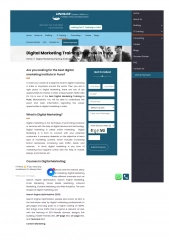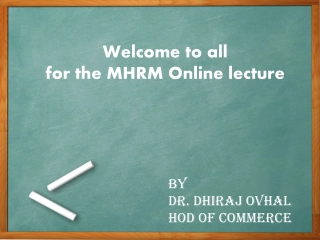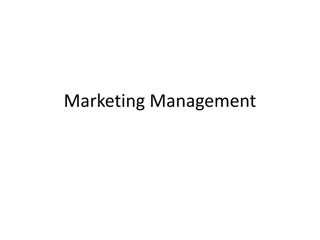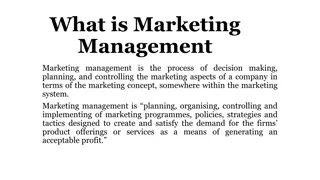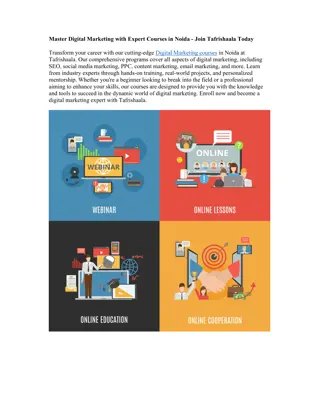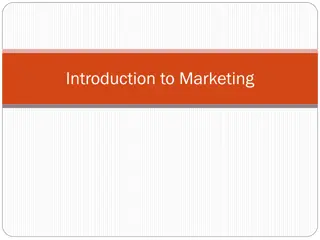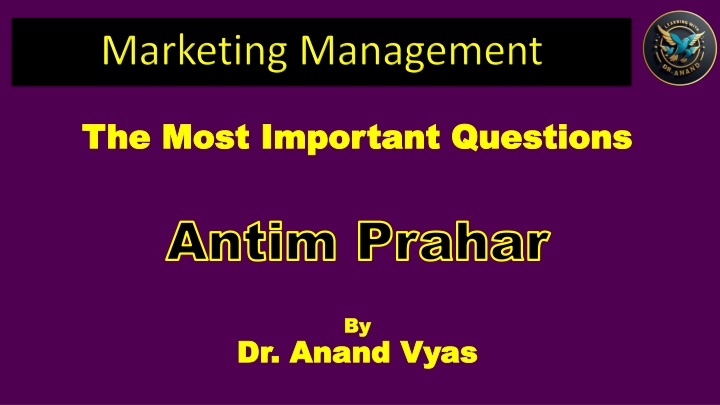
Strategies of Promotion in Marketing: Push vs. Pull Techniques
Learn about push and pull strategies in marketing to create demand and influence consumer behavior. Explore the key features, examples, and advantages of both approaches, along with insights into personal selling concepts, features, and steps involved.
Uploaded on | 0 Views
Download Presentation

Please find below an Image/Link to download the presentation.
The content on the website is provided AS IS for your information and personal use only. It may not be sold, licensed, or shared on other websites without obtaining consent from the author. If you encounter any issues during the download, it is possible that the publisher has removed the file from their server.
You are allowed to download the files provided on this website for personal or commercial use, subject to the condition that they are used lawfully. All files are the property of their respective owners.
The content on the website is provided AS IS for your information and personal use only. It may not be sold, licensed, or shared on other websites without obtaining consent from the author.
E N D
Presentation Transcript
The Most Important Questions The Most Important Questions Antim Antim Prahar Prahar By By Dr. Dr. Anand Anand Vyas Vyas
1 Push-pull strategies of promotion Promotional strategies in marketing are broadly categorized into push and pull strategies. These strategies help businesses create demand for their products and influence customer purchasing behavior. 1. Push Strategy The push strategy focuses on pushing products through the distribution channel to end consumers. The objective is to encourage intermediaries (wholesalers, retailers, and distributors) to stock, promote, and sell the product. Key Features of the Push Strategy: Targets intermediaries (wholesalers, retailers) rather than end consumers. Encourages intermediaries to stock and promote the product. Uses trade promotions like discounts, bonuses, and incentives. Suitable for new products or products in markets with low brand loyalty. Often seen in B2B (Business-to-Business) marketing. Examples of Push Strategy: Trade Promotions Offering discounts, incentives, or bulk purchase deals to retailers to stock the product.
2. Pull Strategy 2. Pull Strategy The pull strategy focuses on creating consumer demand, encouraging customers to actively seek out the product. The objective is to attract end consumers directly so they request the product from retailers. Key Features of the Pull Strategy: Targets end consumers rather than intermediaries. Creates brand awareness and demand through advertising and promotions. Uses mass marketing techniques such as digital marketing, TV ads, and influencer promotions. Works well for strong brands with high customer loyalty. Commonly used in B2C (Business-to-Consumer) marketing. Examples of Pull Strategy: Advertising Campaigns TV, radio, print, and digital ads create brand awareness. Social Media & Influencer Marketing Promoting products through influencers to create direct demand. Public Relations & Brand Image Positive media coverage and brand storytelling to attract customers. Customer Loyalty Programs Discounts, cashback, and rewards to retain customers. Advantages of Pull Strategy:
2 Personal Selling: Concept, Features, and Steps/Process involved in Personal Selling Concept: Personal selling is a communication process where a salesperson directly interacts with potential buyers to persuade them to purchase a product or service. It involves building a one-on-one relationship between the salesperson and the customer, tailoring the sales approach to the individual needs and preferences of the buyer.
Features: Features: Direct Interaction: Personal selling involves face-to-face communication between the salesperson and the customer, allowing for immediate feedback and customization of the sales pitch. Customization: Salespeople can tailor their message and presentation to suit the specific needs and concerns of each individual customer. Relationship Building: It focuses relationships with customers, aiming for long-term customer satisfaction and loyalty. Two-Way Communication: Unlike some other forms of promotion, personal selling allows for a dynamic exchange of information between the salesperson and the customer. Immediate Feedback: Salespeople can receive immediate feedback from customers, allowing them to adjust their approach and address concerns in real-time. on establishing and nurturing
Steps/Process involved in Personal Selling: Steps/Process involved in Personal Selling: Prospecting: Identifying potential customers through various sources such as referrals, existing customer databases, or leads generated from marketing efforts. Pre-Approach: Gathering information about potential customers, understanding their needs, and planning the sales presentation accordingly. Approach: Making initial contact with the customer, creating a positive first impression, and establishing rapport. Presentation: Communicating the features, advantages, and benefits of the product or service. This involves tailoring the message to address the specific needs and preferences of the customer. Handling Objections: Addressing any concerns or objections raised by the customer and providing information or solutions to overcome hesitations. Closing the Sale: Encouraging the customer to make a purchase decision. This may involve asking for the sale directly or using closing techniques to finalize the deal.
Follow-up: Building post-sale relationships by following up with customers, addressing any post-purchase concerns, and ensuring satisfaction. This step is crucial for building long-term customer loyalty. Building and Maintaining Relationships: Continuously nurturing relationships with customers to encourage repeat business, referrals, and positive word-of-mouth. Adapting and Learning: Continuously adapting the sales approach based on customer feedback and learning from each sales interaction to improve future performance.
3 CRM Meaning, Importance and Relationship Marketing Vs. Relationship Management CRM (Customer Relationship Management): Meaning: Customer Relationship Management, commonly known as CRM, refers to the practices, strategies, and technologies that businesses use to manage and analyze customer interactions and data throughout the customer lifecycle. The primary goal of CRM is to improve customer retention, enhance customer satisfaction, and drive overall business growth by creating and maintaining strong, lasting relationships with customers. CRM involves the use of technology platforms, databases, and various tools to gather, analyze, and leverage customer information. This information is then used to personalize interactions, streamline communication, and optimize marketing, sales, and customer service processes.
Importance of Customer Relationship Management Customer Relationship Management (CRM) is a strategic approach that focuses on building and maintaining strong, long-lasting relationships with customers. It involves the use of technology, processes, and data to understand customer needs, preferences, and behaviors. The significance of Customer Relationship Management can be observed in various aspects of business operations: Enhanced Customer Satisfaction: CRM systems enable businesses to gather and analyze customer data, leading to a better understanding of individual preferences and needs. By tailoring products, services, and interactions to match customer expectations, businesses can enhance overall customer satisfaction. Improved Customer Retention: Building strong relationships with customers is key to retaining their loyalty. CRM helps businesses identify and address customer concerns, track purchase histories, and deliver personalized experiences, reducing the likelihood of customers switching to competitors. Increased Customer Loyalty: By providing a personalized and positive experience, CRM contributes to building customer loyalty. Satisfied and loyal customers are more likely to make repeat purchases, refer others to the business, and engage in long-term relationships. Efficient Marketing Strategies: CRM systems allow businesses to segment their customer base, target specific groups with relevant marketing messages, and measure the effectiveness of marketing campaigns. This leads to more targeted and efficient marketing strategies, optimizing resource allocation.
Data-Driven Decision-Making: CRM provides valuable insights into customer behaviors, preferences, and trends. Businesses can use this data to make informed decisions about product development, marketing strategies, and overall business operations. Customer Communication and Engagement: CRM facilitates effective communication with customers through various channels, such as email, social media, and customer portals. Businesses can engage with customers, address their concerns promptly, and provide valuable information, creating a positive and interactive relationship. Cross-Selling and Upselling Opportunities: With a comprehensive view of customer preferences and purchase history, businesses can identify opportunities for cross-selling and upselling. CRM systems help suggest complementary products or upgrades, increasing the average transaction value. Improved Customer Service: CRM systems enable businesses to provide better customer service by centralizing customer information, tracking service requests, and ensuring timely responses. This contributes to a positive customer experience and helps in resolving issues more efficiently. Competitive Advantage: Businesses that effectively implement CRM gain a competitive advantage by understanding their customers better than competitors. This knowledge allows for differentiation, innovation, and the ability to adapt quickly to changing market demands.
Relationship Marketing vs. Relationship Management: Relationship Marketing: Focus: Relationship marketing is a broader marketing philosophy that emphasizes building long-term and mutually beneficial relationships with customers. Approach: It involves creating strong emotional connections between the brand and customers by delivering personalized and meaningful experiences. Goal: The primary goal of relationship marketing is to foster customer loyalty, encourage repeat business, and turn customers into advocates. Strategy: Relationship marketing goes beyond transactions and focuses on understanding customer needs, preferences, and values to create a positive and memorable brand experience. Examples: Loyalty programs, personalized communication, exclusive offers, and community-building initiatives are common strategies in relationship marketing.
Relationship Management: Focus: Relationship management, including Customer Relationship Management (CRM), is a more specific set of practices and technologies aimed at managing interactions and information throughout the customer lifecycle. Approach: It involves the systematic collection, analysis, and utilization of customer data to enhance communication, streamline processes, and improve overall customer satisfaction. Goal: The primary goal of relationship management is to efficiently manage customer interactions at various touchpoints, ensuring a consistent and positive experience. Strategy: Relationship management utilizes tools and platforms to centralize customer data, track interactions, departments such as sales, marketing, and customer service. Examples: CRM software, customer databases, and automated communication systems are examples of relationship management tools. In summary, relationship marketing is a broader marketing strategy focused on building emotional connections and fostering customer loyalty, while relationship management, particularly CRM, is a more specific set of practices and technologies designed to manage customer interactions and information systematically. Both concepts contribute to creating strong and enduring relationships between businesses and their customers. and facilitate communication across
4 Green Marketing and Agile Marketing Green Marketing: Definition: Green marketing, also known as sustainable marketing or environmental marketing, involves promoting products or services that are environmentally friendly or have a reduced impact on the environment. It encompasses strategies and practices that aim to meet the needs of customers while minimizing negative effects on the planet. Agile Marketing: Definition: Agile marketing is an iterative and flexible approach to marketing that draws inspiration from agile principles commonly used in software development. It emphasizes adaptability, collaboration, and rapid response to changes in the market or customer needs.
Comparison: Green marketing is primarily concerned with promoting environmentally friendly products and practices, emphasizing sustainability and responsible consumption. Agile Marketing Focuses on Adaptability and Collaboration: Agile marketing, on the other hand, focuses on the adaptability of marketing processes, collaboration among team members, and the ability to respond quickly to changes in the market. In summary, while green marketing centers around environmentally conscious products and practices, agile marketing is a methodology that prioritizes flexibility, collaboration, and adaptability in marketing processes. While they address different aspects of marketing, businesses may find value in integrating both approaches to align marketing strategies with environmental responsibility and enhance overall agility in responding to dynamic market conditions. Marketing Focuses on Environmental Impact: Green
5 Product Decisions Concept and Product hierarchy 5 Product Decisions Concept and Product hierarchy Product Decisions: Product decisions refer to the strategic choices made by a business regarding the development, design, and management of its product or service offerings. These decisions have a significant impact on the overall success and competitiveness of the business. Key elements of product decisions include: Product Development: Involves the creation of new products or the enhancement of existing ones. This process requires innovation, research, and testing to meet customer needs and stay ahead of competitors. Product Design: Encompasses the aesthetic and functional aspects of a product. Design decisions influence how the product looks, feels, and functions, contributing to its appeal and usability. Product Features: Refers to the specific characteristics and functionalities that distinguish a product. Decisions about features are based on customer preferences, market demands, and competitive differentiation. Brand Name and Branding: Involves choosing an appropriate brand name and creating a brand identity. Branding decisions aim to establish a positive image, build brand recognition, and differentiate the product from others in the market.
Product Packaging: Encompasses the physical presentation of the product, including packaging design, materials, and labeling. Packaging decisions influence product visibility, protection, and customer appeal. Product Life Cycle Management: Involves managing a product through its various life stages, from introduction to growth, maturity, and decline. Businesses must make decisions on product updates, extensions, or discontinuation based on its life cycle. Quality Assurance: Focuses on maintaining and improving the quality of the product. Quality decisions impact customer satisfaction, brand reputation, and long-term success in the market. Product Positioning: Involves determining the product's position in the market relative to competitors. Positioning decisions influence how the product is perceived by target customers and its unique selling proposition.
Product Pricing: Refers to the decisions related to setting the price of the product. Pricing decisions consider factors such as cost, perceived value, market demand, and competitive pricing strategies. Product Distribution: Involves decisions about how the product will be made available to customers. Distribution decisions include choosing distribution channels, logistics, and inventory management.
Product Hierarchy: The product hierarchy is a structured representation of a company's product offerings, organized in layers based on their level of generality or specificity. It provides a systematic way to categorize and manage a diverse range of products. The typical product hierarchy consists of three main levels: Product Family or Product Line: This is the broadest level, representing a group of related products that share common characteristics, target the same customer segment, and serve a similar purpose. For example, a company's line of smartphones or a range of home appliances. Product Category: The second level in the hierarchy represents more specific groups within a product line. Each category comprises products that share certain attributes but may have variations to meet different customer needs. For instance, within a smartphone product line, categories might include budget phones, mid-range phones, and high- end flagship phones.
Individual Product: At the lowest level, individual products are specific offerings within a product category. Each product is distinct, with its own features, specifications, and branding. Continuing with the smartphone example, individual products could be specific models like "Xperia 5" or "Galaxy S21."
6 Introduction: Nature and scope of marketing 6 Introduction: Nature and scope of marketing Marketing is a dynamic and pervasive activity that plays a crucial role in the success of businesses and organizations across various industries. It encompasses a broad range of activities designed to create, communicate, deliver, and exchange value to satisfy the needs and wants of customers, clients, and other stakeholders. The nature and scope of marketing are vast, reflecting its multifaceted role in the business landscape. Nature of Marketing: Customer-Centric: At its core, marketing is centered around understanding and meeting the needs of customers. It involves identifying target markets, analyzing consumer behavior, and developing strategies to create value propositions that resonate with the intended audience. Holistic Approach: Marketing is not limited to just selling products or services. It involves a holistic approach that includes product development, pricing, distribution, and promotion. This integrated approach ensures that all elements of the marketing mix work together to achieve the overall business objectives. Dynamic and Evolving: The business environment is constantly changing, and marketing must adapt to new technologies, consumer trends, and competitive landscapes. Continuous monitoring, analysis, and adaptation are essential for success in the ever-evolving marketplace.
Scope of Marketing: Product and Service Management: Marketing involves the development, positioning, and management of products and services. This includes decisions related to product design, features, branding, and the overall product life cycle. Market Research and Analysis: Understanding the market is a critical aspect of marketing. This involves researching consumer behavior, market trends, and competitive landscapes to make informed decisions and develop effective marketing strategies. Promotion and Communication: Creating awareness and influencing consumer perceptions are key components of marketing. Promotion involves advertising, public relations, sales promotions, and other communication strategies to build brand visibility and stimulate demand. Distribution and Supply Chain Management: Ensuring that products or services reach the right customers at the right time is a vital aspect of marketing. This involves decisions related to distribution channels, logistics, and supply chain management. Pricing Strategies: Determining the appropriate pricing strategy is crucial for achieving business objectives. Marketing professionals analyze costs, competitor pricing, and consumer perceptions to establish pricing that reflects the product or service's value. Relationship Marketing: Building and maintaining long-term relationships with customers is increasingly important. Relationship marketing focuses on customer retention, loyalty programs, and personalized communication to foster a strong connection between the brand and its customers. In conclusion, marketing is a multifaceted discipline that plays a central role in the success of businesses by creating value, satisfying customer needs, and facilitating profitable exchanges. Its dynamic nature and expansive scope make it a fundamental function for organizations seeking to thrive in today's competitive and ever-changing business environment.
7 Marketing mix and Product mix Marketing Mix (4Ps): The marketing mix, often referred to as the 4Ps, is a set of tactical marketing tools that a company uses to pursue its marketing objectives in a target market. The 4Ps stand for Product, Price, Place, and Promotion. Product: Involves decisions about the features, design, quality, and branding of the product or service being offered. It's about creating value for the customer and differentiating the product from competitors. Price: Relates to the strategies and decisions regarding how the product or service will be priced. Pricing considerations include cost analysis, competitor pricing, perceived value, and overall market conditions. Place (Distribution): Focuses on how the product or service reaches the customer. Distribution channels, logistics, inventory management, and the overall availability of the product fall under this category. Promotion: Encompasses the methods used to communicate and promote the product to the target audience. This includes advertising, public relations, sales promotions, and personal selling.
Product Mix: Product Mix: The product mix, also known as the product assortment or product portfolio, refers to the total set of products or services offered by a company. It involves strategic decisions about the range and diversity of products within the company's portfolio. Product Line: A group of related products offered by a company. For example, a smartphone company may have a product line that includes various models with different features and price points. Product Width: Refers to the number of different product lines a company offers. A company with a broad product width has diverse product lines, while a narrow product width implies a more focused product offering. Product Length: Indicates the total number of products within a company's product lines. A company can expand its product length by introducing new products or variations within existing lines. Product Depth: Relates to the variety of versions or variations of a specific product in a product line. For example, a clothing brand may offer a specific type of shirt in various colors and sizes. Consistency: Involves the relationship between different product lines in terms of their use, production requirements, distribution channels, or pricing strategies. A consistent product mix aligns with the overall brand and business strategy.
8 Stages and types in consumer buying decision process The consumer buying decision process is a series of steps that individuals go through when making a purchase. These stages help marketers understand and influence consumer behavior. The typical consumer buying decision process consists of the following stages: Problem Recognition: This is the initial stage where a consumer perceives a need or problem. It could be triggered by internal factors (such as a desire for a new product) or external factors (like an advertisement or a friend's recommendation). Information Search: Once the consumer recognizes a problem or need, they start seeking information about potential solutions. This search can involve internal sources (memory, past experiences) or external sources (friends, family, online reviews, advertisements). Evaluation of Alternatives: At this stage, consumers compare the available options to satisfy their need. They assess factors such as features, benefits, price, and brand reputation. The evaluation may be influenced by personal preferences, past experiences, or recommendations.
Purchase Decision: After evaluating alternatives, the consumer makes the decision to purchase a specific product or service. The actual purchase may be influenced by various factors, including the availability of the product, promotions, or the influence of others. Purchase: This is the stage where the consumer actually acquires the chosen product or service. The purchase process may happen online, in-store, or through other channels, depending on the nature of the product and consumer preferences. Post-Purchase Evaluation: After making a purchase, consumers assess their satisfaction with the product or service. If expectations are met or exceeded, it reinforces positive feelings. If there's dissatisfaction, it may lead to post-purchase dissonance or regret.
Types of Consumer Buying Decision Processes: Types of Consumer Buying Decision Processes: Routine Buying Decision: In routine decision-making, consumers go through a quick and simple process. This is common for low-cost, frequently purchased items where there is little risk involved. Consumers often have well-established preferences and don't invest much time in information search or evaluation. Limited Decision Making: This type occurs when consumers are buying products that are somewhat important, but they don't want to spend a significant amount of time researching or evaluating alternatives. There is a moderate level of information search and consideration involved. Extensive Decision Making: Extensive decision-making is typical for high-involvement purchases with significant consequences. Consumers invest time and effort in researching, comparing, and evaluating alternatives. Examples include buying a car or a house.
Impulse Buying: Impulse buying is characterized by spontaneous and unplanned purchases. Consumers make these decisions quickly without much deliberation. Factors such as product displays, promotions, and emotional triggers often drive impulse purchases. Socially Influenced Decision Making: Social factors, such as peer pressure, family influence, or cultural norms, play a significant role in socially influenced decision making. Consumers may be swayed by the opinions or preferences of others in their social circles. Habitual Buying Decision: Habitual buying involves repeated purchasing of a particular brand or product out of habit, convenience, or loyalty. Consumers may not actively consider alternatives and stick to familiar choices.
9 AIDA Model The AIDA model is a classic marketing communication framework that outlines the stages a consumer goes through during the process of making a purchasing decision. The acronym "AIDA" stands for Attention, Interest, Desire, and Action. This model helps marketers understand and guide consumers through the various steps in the communication and persuasion process. Attention: The first stage is to grab the attention of the target audience. This can be achieved through compelling headlines, eye-catching visuals, or other attention-grabbing elements in advertising or promotional materials. The goal is to create awareness and make the consumer notice the product or service. Interest: Once attention is captured, the next step is to generate interest in the product or service. Marketers aim to provide information that engages the audience and highlights the features, benefits, or unique selling propositions of the offering. This stage involves maintaining the consumer's attention and encouraging further exploration.
Desire: After generating interest, the goal is to build desire or a sense of want or need for the product or service. Marketers emphasize the value proposition, showcase the benefits, and create a positive perception to make the offering more appealing. The objective is to stimulate an emotional or rational connection with the consumer. Action: The final stage of the AIDA model is to prompt the consumer to take action. This action could involve making a purchase, filling out a form, subscribing to a newsletter, or any other desired response. Marketers use clear and compelling calls-to-action (CTAs) to guide consumers toward the intended behavior.
10 Market segmentation, Targeting and Positioning 1. Market Segmentation: Market segmentation is the process of dividing a broad market into smaller, distinct groups of consumers who have similar needs, wants, characteristics, or behaviors. The purpose of segmentation is to better understand and meet the specific requirements of different customer segments. The criteria for segmentation can include demographics, psychographics, behavior, geography, or other relevant factors. Here are the main steps in market segmentation: Identification of Variables: Determine the factors that will be used to segment the market. These could be demographics (age, gender, income), psychographics (lifestyle, values, attitudes), behavior (usage patterns, brand loyalty), or geographic location. Market Analysis: Conduct research to analyze and understand the needs, preferences, and behaviors of different segments. This involves collecting data to identify distinct characteristics and patterns within each segment. Segmentation Process: Group consumers with similar characteristics into segments. The goal is to create segments that are internally homogeneous (similar within) and externally heterogeneous (different from each other). Profile Development: Create detailed profiles or personas for each segment. These profiles should include information on demographics, psychographics, behaviors, and other relevant characteristics.
2. Targeting: Once market segments are identified, the next step is targeting selecting one or more specific segments to focus on based on the attractiveness and compatibility with the business's resources and objectives. Targeting involves evaluating the potential of each segment and deciding where to direct marketing efforts. The key steps in targeting are: Evaluate Segment Attractiveness: Assess the size, growth potential, profitability, and alignment with the business's capabilities for each segment. Consider factors such as competition, barriers to entry, and potential for differentiation. Select Target Segments: Decide which segment(s) the business will target. This involves choosing the segment(s) that align with the company's goals and where the company can offer superior value compared to competitors. Develop Targeting Strategies: Once the target segment(s) are identified, develop marketing strategies tailored to the specific needs and characteristics of those segments. This may include product customization, pricing strategies, and communication methods.
3. Positioning: Positioning is about creating a distinct image and perception of a product or brand in the minds of the target customers within the chosen market segment. It's about how a product is positioned relative to its competitors and how it's perceived by the target audience. Key steps in the positioning process include: Identify Competitive Advantages: Determine what sets the product or brand apart from competitors. This could be based on features, quality, price, convenience, or other factors. Define the Positioning Strategy: Clearly articulate the desired position of the product in the minds of the target customers. This involves crafting a unique selling proposition (USP) that communicates the value proposition to the target audience. Communicate the Positioning: Develop marketing messages and communication strategies that convey the intended positioning to the target audience. This includes advertising, branding, and other promotional efforts. Monitor and Adjust Positioning: Continuously monitor the market, competition, and customer feedback. If necessary, adjust the positioning strategy to stay relevant and aligned with market dynamics. In summary, Market Segmentation, Targeting, and Positioning (STP) are interconnected strategic processes that help businesses understand their customers better, focus their efforts on the most promising segments, and create a distinctive and compelling position in the market. These concepts are fundamental to developing effective marketing strategies that resonate with the specific needs and preferences of the target audience.
12 Brand Types, Brand equity and Brand Positioning Brand Types: Product Brands: These are brands associated with specific products. Consumers often make purchase decisions based on the reputation and attributes of the individual product. Corporate Brands: Also known as umbrella brands, these brands represent the entire company and its range of products or services. Examples include Google, Samsung, and Coca-Cola. Service Brands: These brands are associated with services rather than tangible products. Service brands rely on the quality of the service experience, and examples include FedEx, American Express, and Marriott. Personal Brands: Personal brands are linked to individuals, often celebrities or influencers. The reputation and image of the person become synonymous with the brand itself.
Retailer Brands (Private Labels): These brands are owned and sold by retailers. Retailer brands often offer comparable quality to national brands but at a lower price. Examples include Kirkland Signature (Costco) or Great Value (Walmart). Family Brands: Family brands consist of a range of related products under one brand name. Each product benefits from the overall brand reputation. Examples include Microsoft Office or Sony Xperia. Individual Brands: In contrast to family brands, individual brands are standalone products with their own distinct brand names. Each product has its own identity and is not directly tied to other products under the same brand.
Brand Equity: Brand equity refers to the value and strength of a brand in the eyes of consumers. It encompasses the perceptions, associations, and attitudes that consumers have towards a brand. Strong brand equity is essential for building customer loyalty, influencing maintaining a competitive advantage. Key components of brand equity include: Brand Awareness: The extent to which consumers recognize and recall a brand. High brand awareness is crucial for attracting new customers and retaining existing ones. Brand Association: The mental connections and associations that consumers make with a brand. This can include attributes, emotions, or values linked to the brand. Brand Loyalty: The degree to which customers are committed to a brand and consistently choose it over competitors. Building brand loyalty involves delivering consistent quality and positive experiences. purchasing decisions, and
Perceived Quality: Consumers' perception of the overall quality or excellence of a brand's products or services. Quality perceptions significantly impact brand equity. Brand Image: The overall impression that consumers have about a brand. This includes the visual elements (logo, design) as well as the emotional and experiential aspects. Brand Personality: The human characteristics or personality traits attributed to a brand. This helps consumers connect with the brand on a personal level.
Brand Essence: The core attributes or values that define the brand. It encapsulates the fundamental nature of the brand and what it stands for. Competitive Framework: Understanding how the brand is positioned relative to its competitors. This involves analyzing the strengths and weaknesses of competing brands in the same market space. Brand Tagline or Slogan: A concise and memorable statement that captures the essence of the brand and communicates its positioning. It serves as a quick reminder of what the brand represents. In summary, understanding different brand types, building strong brand equity, and strategically positioning a brand are crucial aspects of successful branding. These elements collectively contribute to creating a positive and lasting connection between the brand and its target audience.
Brand Positioning: Brand positioning involves creating a distinct and desirable place for a brand in the minds of target customers within the competitive landscape. It is about defining how a brand wants to be perceived in relation to its competitors. Key elements of brand positioning include: Target Audience: Identifying and understanding the specific segment of the market that the brand aims to appeal to. This includes demographic, psychographic, and behavioral factors. Points of Parity (PoP) and Points of Difference (PoD): Points of parity are characteristics shared with competitors, ensuring the brand is perceived as a legitimate player in the market. Points of difference are unique attributes that distinguish the brand from competitors. Brand Promise: A commitment or pledge made by the brand to its customers. This promise reflects what customers can expect from the brand and sets expectations for the brand experience.
13 Pricing Strategies, Types (Skimming pricing and Penetration pricing) A business can use a variety of pricing strategies when selling a product or service. The price can be set to maximize profitability for each unit sold or from the market overall. It can be used to defend an existing market from new entrants, to increase market share within a market or to enter a new market.
Penetration Pricing: Simple Explanation: Start with a low price to quickly get a lot of customers. Then, gradually raise the price once you've grabbed a big share of the market. Example: Imagine a new video streaming service offering a super cheap subscription at first to get many people to sign up fast. Later, they may increase the price. Skimming Pricing: Simple Explanation: Charge a high price because your product is special or new. However, be ready for more competitors to join, and the price might drop later. Example: When digital watches first came out in the 1970s, they were expensive. But as more companies entered the market, prices fell.
Competition Pricing: Simple Explanation: Set your price the same as your competitors. It's like saying, "If they're charging that much, so should we." Example: A new coffee maker enters the market and sees that competitors sell it for $25. They decide to sell theirs at the same price. Product Line Pricing: Simple Explanation: Offer different versions of a product at different prices. Customers choose based on what they need. Example: Car washes might have a basic wash for $2, a wash and wax for $4, and a full package for $6.
Psychological Pricing: Simple Explanation: Use prices that play with emotions. For example, instead of $1, say it's $0.99 to make it sound cheaper. Example: A product might be priced at $9.99 instead of $10 because it seems more affordable. Cost Plus Pricing: Simple Explanation: Calculate all costs to make the product and add some extra money for profit. That's your price. Example: A new printer costs $78 to produce, so they decide to sell it at $78 to break even. Cost-Based Pricing: Simple Explanation: Set prices based on how much it costs to make and sell the product, adding a bit extra for profit. Example: Ryanair and Walmart try to be low-cost producers to offer lower prices to customers.
Optional Product Pricing: Simple Explanation: Sell extra features or add-ons to increase the overall price. Customers pay more for additional benefits. Example: Airlines charging extra for a window seat or additional luggage. Premium Pricing: Simple Explanation: Charge a high price because your brand is unique or luxurious. People pay more for something exclusive. Example: Premium prices for Cunard Cruises, Savoy Hotel rooms, or first-class air travel. Bundle Pricing: Simple Explanation: Sell several products together in a package for a lower price than if bought separately. Customers get a deal. Example: Fast-food combos offering a burger, fries, and a drink for less than the individual prices.
14 Sales Promotion Mix The sales promotion mix refers to a combination of promotional tools and techniques that companies use to stimulate immediate sales and boost consumer interest in their products or services. The sales promotion mix is a subset of the overall marketing mix and is designed to create a sense of urgency or excitement among consumers. Here are some key components of the sales promotion mix: Discounts: Offering price reductions or discounts on products to encourage quick purchases. This can include percentage discounts, buy-one-get-one-free (BOGO) offers, or seasonal discounts. Coupons: Distributing printed or digital coupons that customers can redeem for discounts at the time of purchase. Coupons can be included in advertising, sent directly to consumers, or made available through various channels. Contests and Sweepstakes: Organizing competitions or games where customers can participate and stand a chance to win prizes. Contests typically involve skill-based entries, while sweepstakes are more luck- based. Rebates: Offering partial refunds to customers after the purchase. Customers receive money back by submitting proof of purchase, such as a receipt or barcode.
Samples: Providing free samples of products to customers as a way to introduce new products or encourage trial. This is common in the food, cosmetics, and personal care industries. Gifts and Premiums: Giving away free items or offering special gifts with a purchase. Premiums are often branded merchandise or complementary products given as a bonus. Loyalty Programs: Rewarding customers for their repeat business by offering loyalty cards, points, or other incentives. Loyalty programs encourage customers to make frequent purchases to earn rewards.
Point-of-Purchase Displays: Creating visually appealing displays at the point of sale to attract attention and promote specific products. This can include special signage, banners, or product arrangements. Flash Sales: Limited-time sales events with significant discounts or promotions. Flash sales create a sense of urgency and drive immediate purchasing decisions. Joint Promotions: Collaborating with other businesses to create promotions or offers that benefit both parties. For example, a partnership between a coffee shop and a bookstore could involve cross-promotional discounts. Trade Promotions: Offering incentives to retailers or distributors to encourage them to carry and promote a product. Trade promotions can include discounts, promotional allowances, or co-op advertising.
Buyer Rewards: Providing rewards or incentives directly to the end consumer for making a purchase. This can include cashback offers, gift cards, or special discounts on future purchases. Limited-Time Offers: Introducing special promotions or discounts for a limited duration to create a sense of urgency and prompt immediate action from consumers. The effectiveness of the sales promotion mix depends on the specific goals, target audience, and product characteristics. Successful sales promotions can drive short-term sales, attract new customers, and enhance brand visibility. However, it's crucial for businesses to carefully plan and integrate sales promotions into their overall marketing strategy to achieve sustainable and long-term success.



